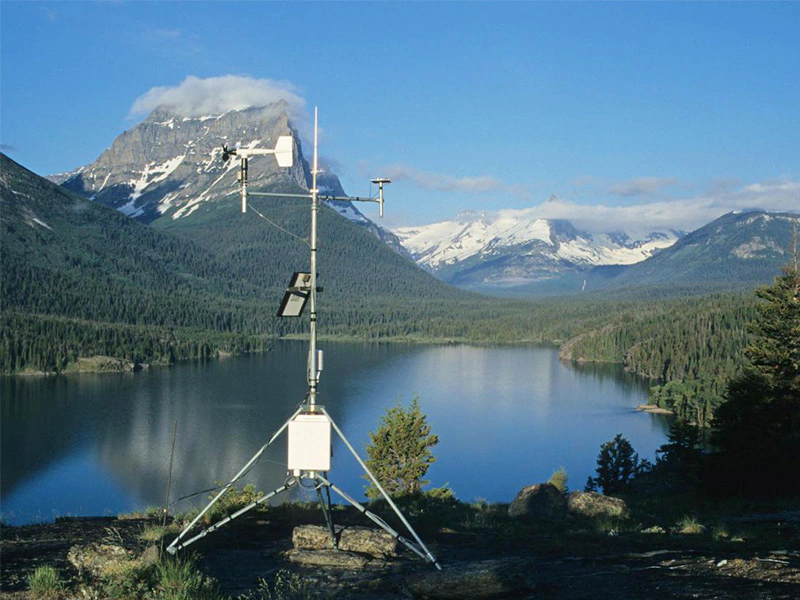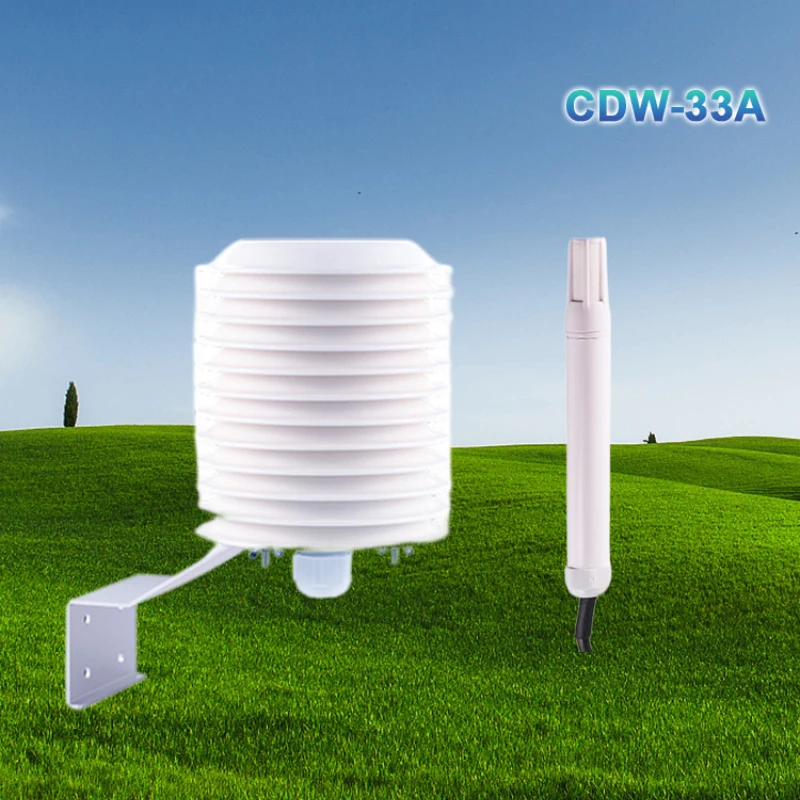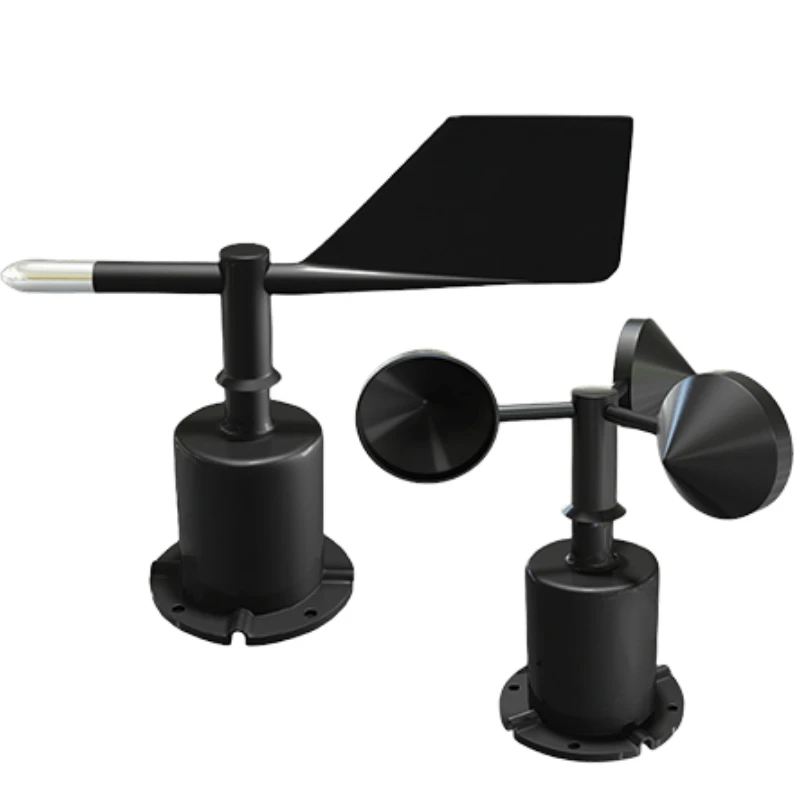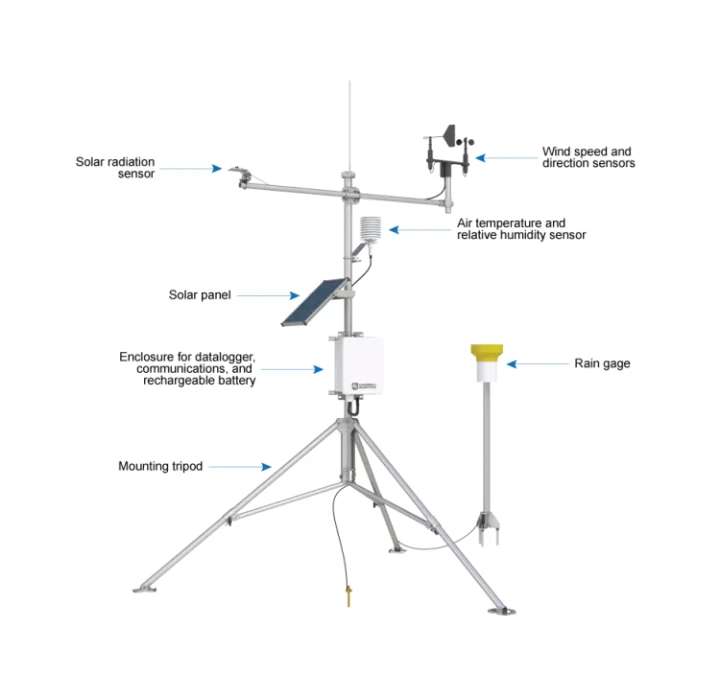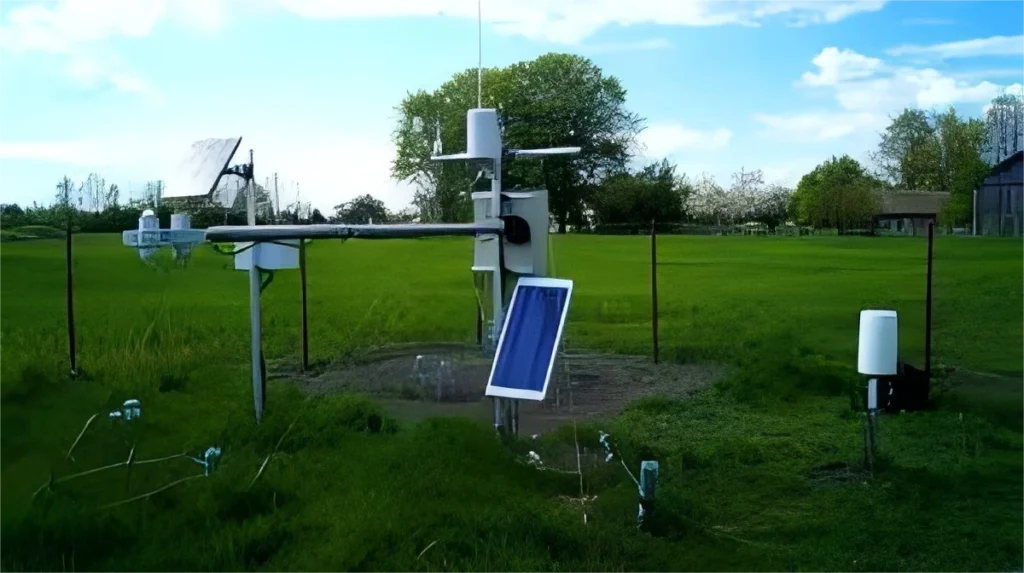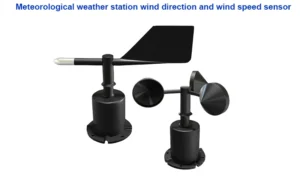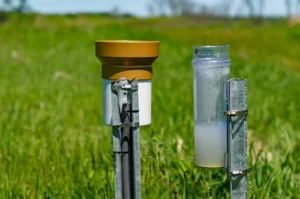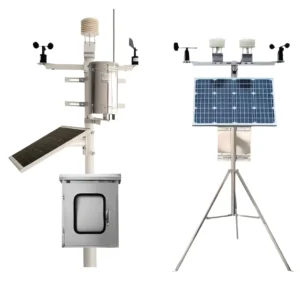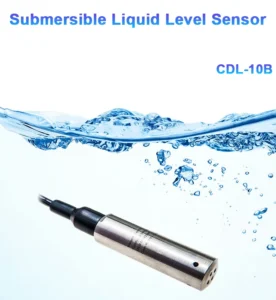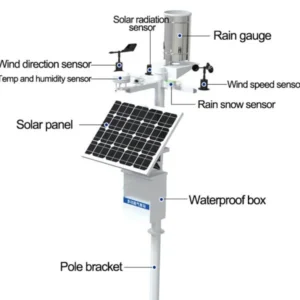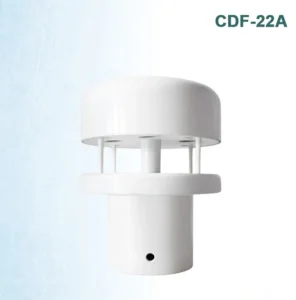What is a meteorological station?
A meteorological station is a special tool that collects and studies weather data. It looks at things like temperature, humidity, air pressure, light, and rainfall to predict changes in the weather. It also helps manage various weather-related risks.
A typical weather station has one pole. This pole holds different weather sensors.
The main unit for collecting weather maps data is at the top. The site is often clear of nearby buildings and obstacles. This helps make sure the data collected is accurate.
Elements of a weather station
Weather monitoring systems usually have three main parts: a measurement unit, a power supply, and a control unit.
Weather observation stations collect data using different weather sensors. A full weather station system has these sensors:
– Temperature and humidity sensor
– Wind speed and direction sensor
– Dew point detector
1. Temperature and humidity detector
To keep the measurement data safe from sunlight and rain, the detector is inside a cover. This cover keeps it safe from the sun. It also helps keep track of the temperature and humidity around it.
Temperature and humidity are key factors in studying the weather. There are different types of detectors for these factors. They include resistive, capacitive, thermal, and others.
2. Wind speed detector and wind direction detector
Tracking wind speed and direction is key for monitoring the weather. Fields such as farming, navigation, and transport need precise wind data.
Engineers create wind sensors, such as mechanical, ultrasonic, and magneto-electric types. These sensors work without any blocks to give reliable data. They help make sure the data is accurate and useful.
3. Solar radiation sensor
People use this device to measure how strong solar radiation is. There are three types of solar radiation sensors: total, direct, and scattered. We can also group them by wavelength. This stations include sensors for visible light, UV light, and infrared light, among others.
Installers often put solar radiation sensors on flat or sloped surfaces. This helps them get more sunlight. It also cuts down on shading and reflections from nearby things.
4. Rain gauge
We call devices that measure rainfall rain gauges. There are two main types of these weather instruments: mechanical and electronic. Mechanical rain gauges usually have three types: funnel, bucket, and float. On the other hand, electronic rain gauges often use photoelectric, acoustic wave, and radar technologies.
Mechanical rain gauges are simple and cheap. However, they need manual cleaning and data reading. Electronic rain gauges are more complex and cost more.
They offer automation. You can watch and share data from far away.
5. Rain and Snow Sensor
This device measures rain and snow. It comes in two versions: one with automatic heating and one without. You need to install both types at an angle. This helps stop water from building up on the surface, which can cause icing.
6. Ultraviolet Sensor
This meteorological station equipment is used to measure the strength of ultraviolet light. Researchers divide UV sensors into two types: broadband and narrowband. Broadband UV sensors measure light intensity over the whole UV spectrum. In contrast, narrowband UV sensors focus on a specific range of wavelengths.
Installers often put UV sensors on flat or sloped surfaces. This helps them get more sunlight and reduce shading and reflections from nearby things.
7. Dew Point Sensor
This device can measure the temperature at the dew point directly. It also shows the humidity levels in the air. Common types of dew-point sensors are thin-film capacitive, resistive, and chilled-mirror
8. Additional Sensors
Many people add extra sensors for high and low pressure systems, light, and noise inside the solar radiation shield. Engineers made this shield to protect personal weather sensors. It has several shutters that block sunlight, rain, and other outside elements. This keeps the sensors safe and allows for good ventilation.
This keeps the air temperature inside and outside the shield similar. We can also add more sensors for gases, soil, and other needs.
Power Supply System
The weather station can use both a regular power supply and a solar power system. To use the regular power supply, just connect the power cable to the main unit. The solar power setup has solar panels, lead-acid batteries, waterproof enclosures, and controllers.
Control Unit
The central monitoring unit gathers data from each scale weather sensor. It uploads this information and powers the sensors. It can also send commands to the monitoring platform. The monitoring host and different signal and power cables work together to help transmit data.
Types of Weather Instruments and Their Applications
Farm Weather Station
Agricultural weather stations help measure climate changes in areas like farms. Farmers can place these stations in wheat fields. They track air temperature, humidity barometric pressure, wind speed, wind direction, and light intensity.
This real-time data helps farmers see weather changes. It also helps them make farming plans that fit crop growth.
Crops grow in different stages. Farmers can adjust watering, fertilizing, and other methods. This helps improve growth and quality.
Meteorologists mainly use weather stations to watch highways, railways, airports, and other places. It works by itself and does not need human supervision.
Engineers created this traffic weather station to check road weather conditions. It looks at visibility, weather factors, and water vapor levels on the road. Its purpose is to quickly find unusual weather and environmental conditions on different road sections. This helps weather and traffic managers make better choices.
Forest meteorological station
A forest weather station is a special place. It is used to watch and record weather data in forests. It meets the needs of weather observation and helps with forest management.
We can help stop forest fires. We do this by keeping an eye on the weather.
These factors include wind speed, air temperature, humidity, and sunlight. They are very important in areas that often have fires. This information helps guide relief efforts to protect forests after fires occur.
Port weather station
Port weather stations mainly check the weather in port areas. Weather conditions, such as wind speed and direction, have a big impact on ships and port operations.
Keeping an eye on the weather is important for ports to operate well. These conditions impact how ships come in, go out, load, unload, and dock.
Using port weather stations gives real-time data on wind, waves, fog, and visibility. This helps ships navigate safely in and out of the port, even in bad weather.
Campus weather stations help teach students about different weather disasters. This improves their skills in handling these situations.
Setting up these stations on campuses helps students learn about the weather. They can make their own observations. This helps them understand weather events better.
Why is a meteorological station significant?
Forecasting the weather
Weather stations are important for gathering various weather data. They collect information from the ground, air, and oceans. This includes temperature, humidity, atmospheric pressure, wind direction, and wind speed. They also measure rain, snow, sunshine, and ground temperature.
With this information, weather stations can predict upcoming weather. This includes storms, typhoons, tornadoes, and other natural disasters. This ability allows governments and the public to take steps to lower injuries and property damage from bad weather.
Agricultural production
Weather stations are very important for farming. Farmers deal with problems from local and global warming and climate change. They rely on accurate weather forecasts to choose the right crops and the best times to plant.
These stations collect and share data. This helps farmers plan and manage crop yields using weather forecasts.
Management of Water Resources
Good management of water resources is important for many countries. Automatic weather stations help by tracking changes in water levels and flows in water bodies.
This information helps governments create different water management plans. These plans protect water quality and availability. The stations measure snow depth and river ice thickness. This data is useful for planning and operating hydropower plants in winter.
Aviation and Navigation
Weather stations are important for aviation and maritime operations. They provide essential data. Pilots and ship captains depend on this weather information. It helps them choose the best times for takeoff and landing.
Automatic weather stations measure changes in wind speed and direction. This helps reduce risks for both aircraft and ships.
Climate Research
Weather stations collect various data to help with weather forecasting. They record atmospheric phenomena sciences and atmospheric physics, weather events, and ocean changes. This information allows scientists to study climate change, weather patterns, and their causes.
This information is important for global climate modeling and mesoscale word meteorology deals research. It helps improve the accuracy of weather predictions.
